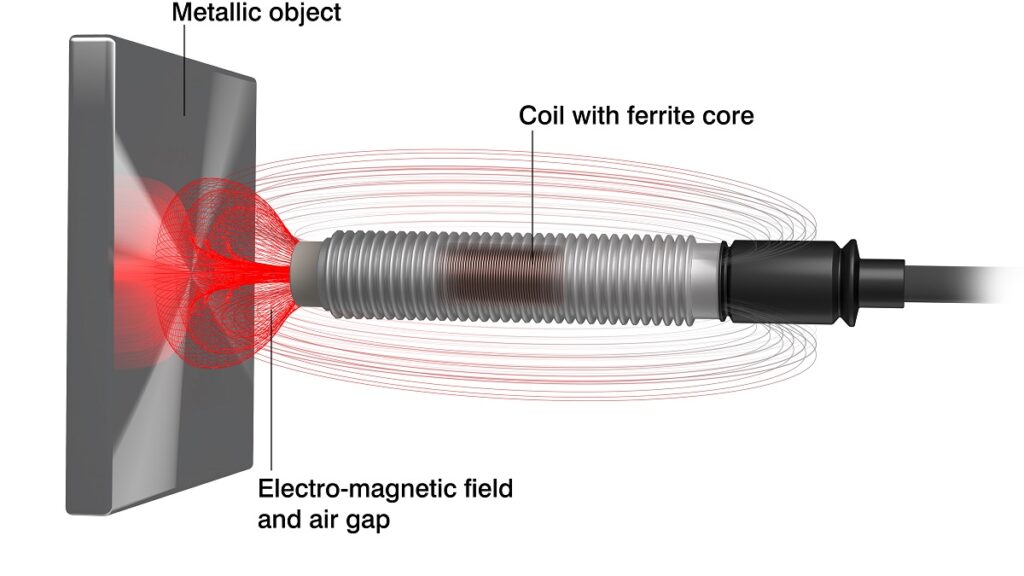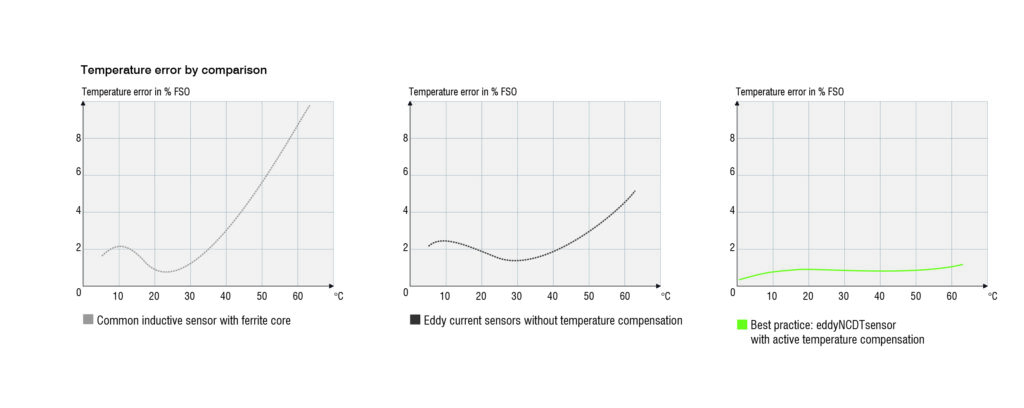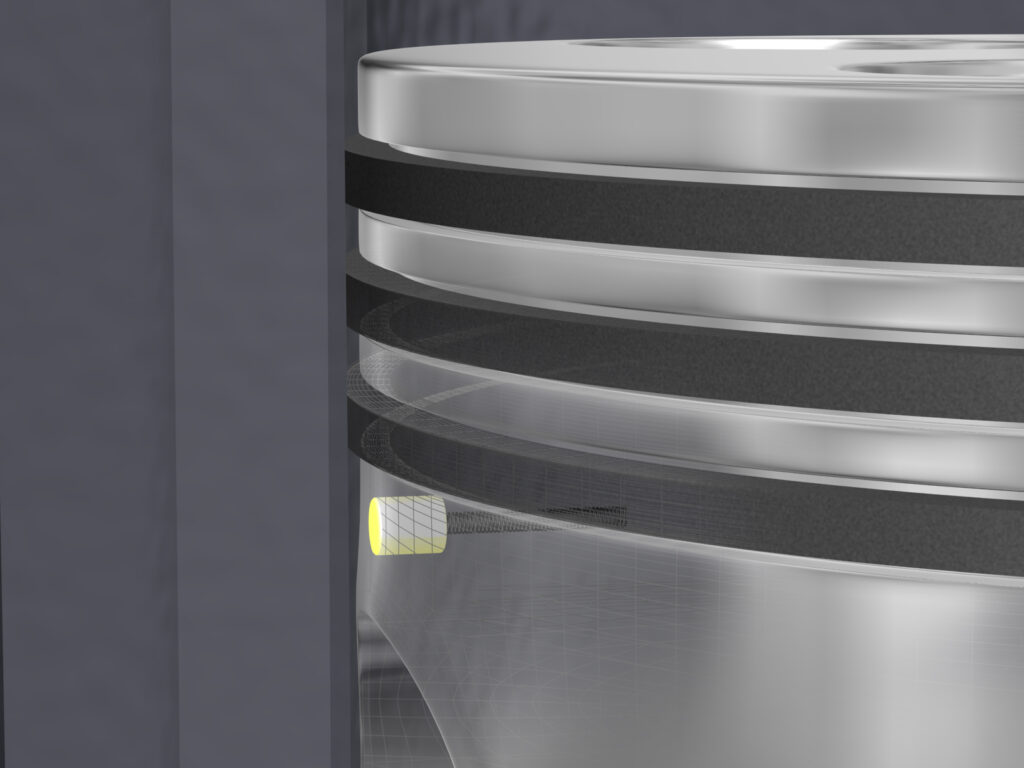By Glenn Wedgbrow, Business Development Manager, Micro-Epsilon UK
Recent advances in eddy-current sensor design, integration, packaging and their overall cost reduction have made these sensors a much more attractive option compared to inductive switches and displacement sensors, particularly where high-linearity, high-speed measurements and high resolution are of crucial importance. Both eddy-current sensors as well as inductive switches and displacement sensors have their respective advantages and disadvantages.
Inductive sensors
The classic inductive displacement sensor comprises a coil wound around a ferromagnetic core. When excited by an alternating current from an oscillator-based driver circuit, the coil generates a magnetic field concentrated around the core; see Figure 1. The lines of flux interact with the target conductor as it approaches, creating eddy currents that are the reverse of the initial excitation current and have the effect of reducing the voltage across the oscillator. These variations in voltage due to the change in air gap distance are detected and converted to an analogue output signal, such as a 4-20mA loop, and then processed upstream to determine displacement.

Figure 1: Inductive displacement sensor
A proximity sensor, also called a proximity switch, is a simplified application of the principles behind the induction effect, detecting only whether or not an object (the conductive target) is present. A comparator (Schmitt trigger) detects the drop in voltage and sends a signal to an amplifier. This in turn switches the output in a binary manner – i.e., the output can be normally open (NO) or normally closed (NC), depending on the configuration.
Because of the ferromagnetic core in an inductive displacement sensor, the output is non-linear and so it needs to be linearised either in the sensor electronics or mathematically using polynomials in the plant or machine control system.
Along with non-linearity, another downside of using a ferromagnetic core is the “iron losses” due to the core itself absorbing the magnetic field. These losses increase with frequency, to the extent that an inductive displacement sensor maxes out at around 50 measurements per second.
A third problem with these sensors is their poor tolerance of wide temperature variations because of the high thermal coefficient of expansion of the ferrite core material. This wide variation makes temperature compensation very difficult, usually resulting in a large thermal drift of inductive displacement sensors.
Eddy-current sensors
To overcome these limitations, a certain class of inductive displacement sensor called “eddy-current sensors” (Figure 2) has been developed that use an air-core coil rather than ferrite.

Figure 2: Eddy-current sensor
While the eddy current sensor’s operating principles are in line with Faraday’s Laws, it is the eddy-currents’ effect on the impedance of the coil that is measured rather than the oscillator’s voltage change. The controller calculates the impedance by looking at the change in the amplitude and phase position of the sensor coil.
Benefits of eddy current include non-contact measurement of displacement or distance, high resolution and temperature stability, temperature range -40°C to 200°C, robust and reliable sensors, resistant to oil, dust and dirt, and more.
High-performance sensing
While all these sensors detect targets such as metals and ferromagnetic and non-ferromagnetic materials in harsh, non-contact environments, the eddy-current-sensor’s architecture, as well as advanced electronics, manufacturing and calibration techniques, make it a much higher performing device. Its performance characteristics can be split into two categories: inherent and resulting from product design, manufacturing and calibration. Of the three inherent features, the most beneficial are:
- Very high measurement frequency, to 5kHz;
- High resolution, to 0.5µm; and
- High linearity and temperature stability.
Since it’s an air-core coil rather than ferrite, an alternating current to 1MHz can be used, although the electronics in devices such as the Micro-Epsilon eddyNCDT3001 and NCDT3005 provide measurement frequencies of 5kHz – ten times higher than inductive displacement counterparts that typically reach 50Hz (translating to 50 measurements per second). Higher-end eddy-current sensors reach 100kHz.
In terms of linearity and temperature, the air-core coil does not have to deal with the flux losses or compensate for the thermal expansion of a ferrite core, hence the 10x linearity improvement. This linearity can be further enhanced though the manufacturing and calibration process, and changes in material; see Figure 3.

Figure 3: Temperature cycling of the sensor
While some inductive displacement sensors have compensation also built into the sensor, it’s typically limited to ±3-5% of the full-scale output (FSO). Eddy-current sensors provide compensation for the full measurement channel (± 0.025% FSO.) It’s also important to note that for maximum accuracy eddy-current sensors are calibrated to the target material at the factory, which puts a higher premium on these devices.
Removing housing limitations
Both proximity and inductive displacement sensors can be housed in solid metal. Eddy-current-sensors’ operating principle means they must use a non-metallic cap. Despite this, Micro-Epsilon edd- current sensors are still certified to IP67. In addition, the packaging side of eddy-current sensors has been advancing rapidly, now the electronics being integrated into the device.
Micro-Epsilon’s eddyNCDT 3001 product line signifies a new class of eddy-current sensors that come in an M12 housing with both integrated controller and signal-conditioning unit. This makes them much more amenable to standard mechanical formats and requirements, and a more attractive replacement for inductive displacement sensors.
Micro-Epsilon’s eddyNCDT3005 line offers separate compact electronics, allowing different sensor measuring ranges to be packaged with compact “in-cable” M12 electronics. Also, the voltage output is the same as inductive displacement sensors, covering the full 0.5-9.5V, making them fully comparable on a 1:1 basis.
Applications
The high cut-off frequency of eddy-current sensors enables metrological detection of distances even in high-speed processes such as machine tools and crankshafts. IP67 protection ensures they can be used in harsh industrial environments where dirt or humidity will affect the measurement. A classic example is monitoring the lubricating gap in a combustion engine (Figure 4) or measuring oil film thickness in hydrostatic bearings (Figure 5).

Figure 4: High-precision, robustness, linearity and temperature tolerance allow an eddyNCDT sensor to track parameters such as the lubrication gap in a combustion engine

Figure 5: The compact M12 eddy-current sensors are often used for monitoring oil film thickness, e.g., in hydrostatic bearings. The sensors measure the distance from the metallic target “through” the oil film to determine the oil gap
When using eddyNCDT sensors, care must be taken to ensure they are placed as close as possible to 90˚ relative to the target surface in order to achieve the highest resolution and measurement accuracy. Sometimes an exact right-angle mounting of the sensor to the target is difficult or impossible; see Figure 6.

Figure 6: Sometimes it’s difficult to achieve a right-angle placement to achieve the highest performance from an eddy-current sensor. Refer to the manufacturer’s charts to work out how to compensate accordingly
In such cases, the measured values will deviate marginally from those acquired at a right angle, so use the sensor supplier’s graphs to factor in the effect of a tilted sensor. For example, with a 4mm sensor and an aluminium target, an inclination of ±4o can be accepted and neglected in most applications. For placement, note that the use of an air core means that the distance from sensor head to target should be 4mm or less.









